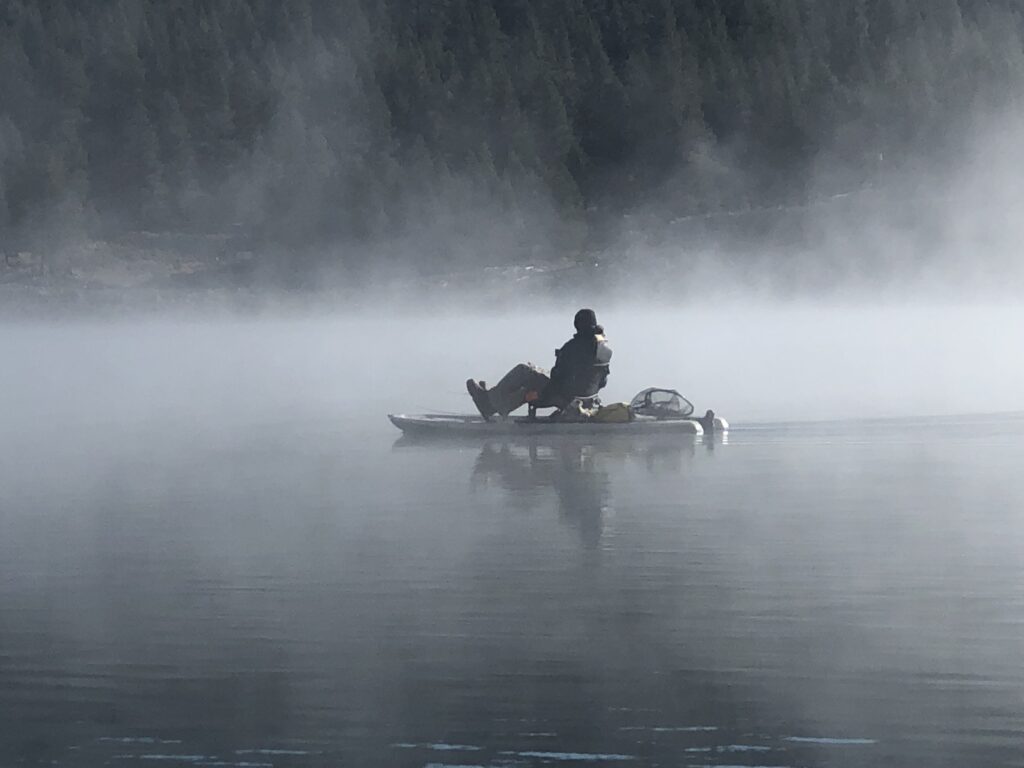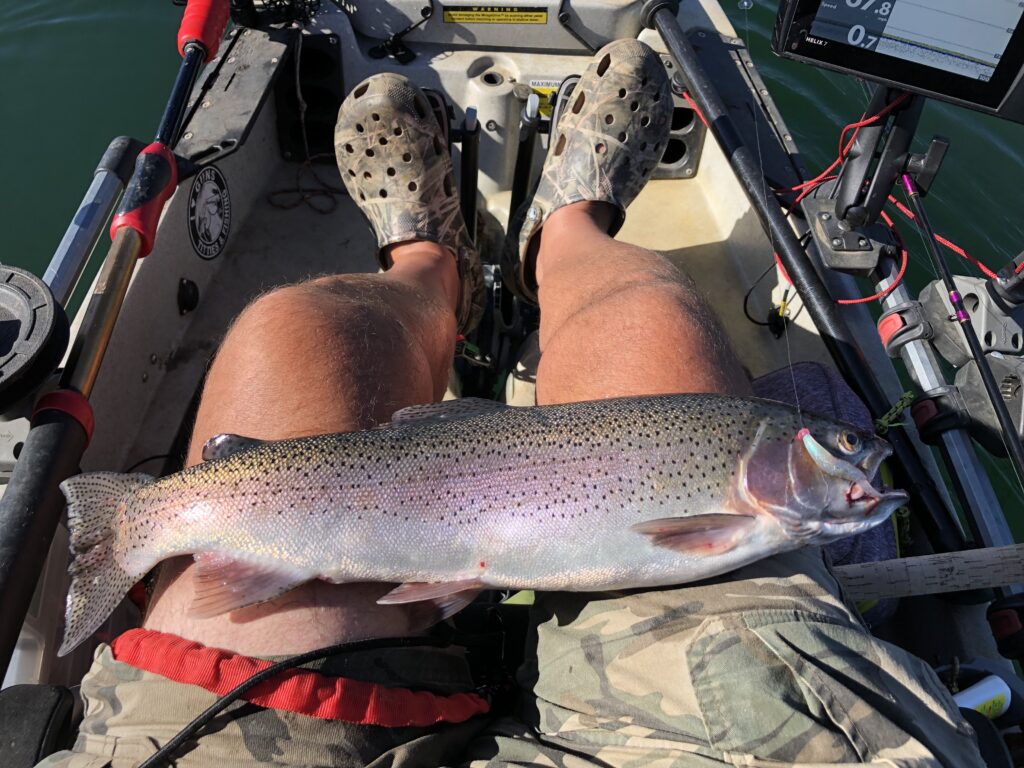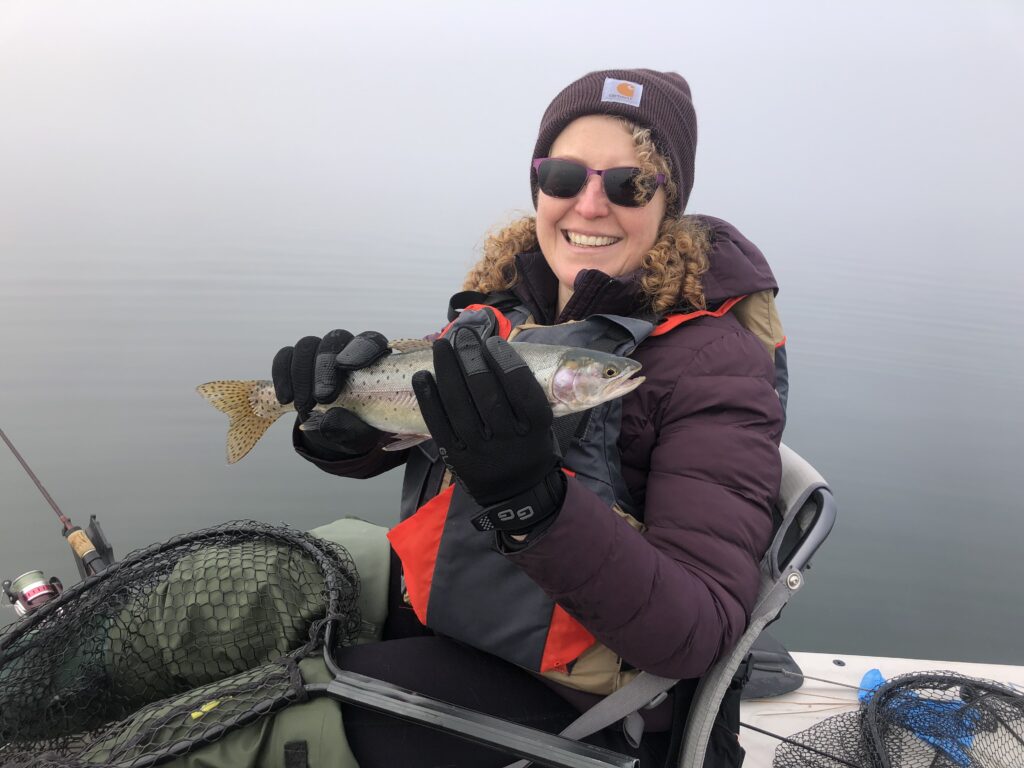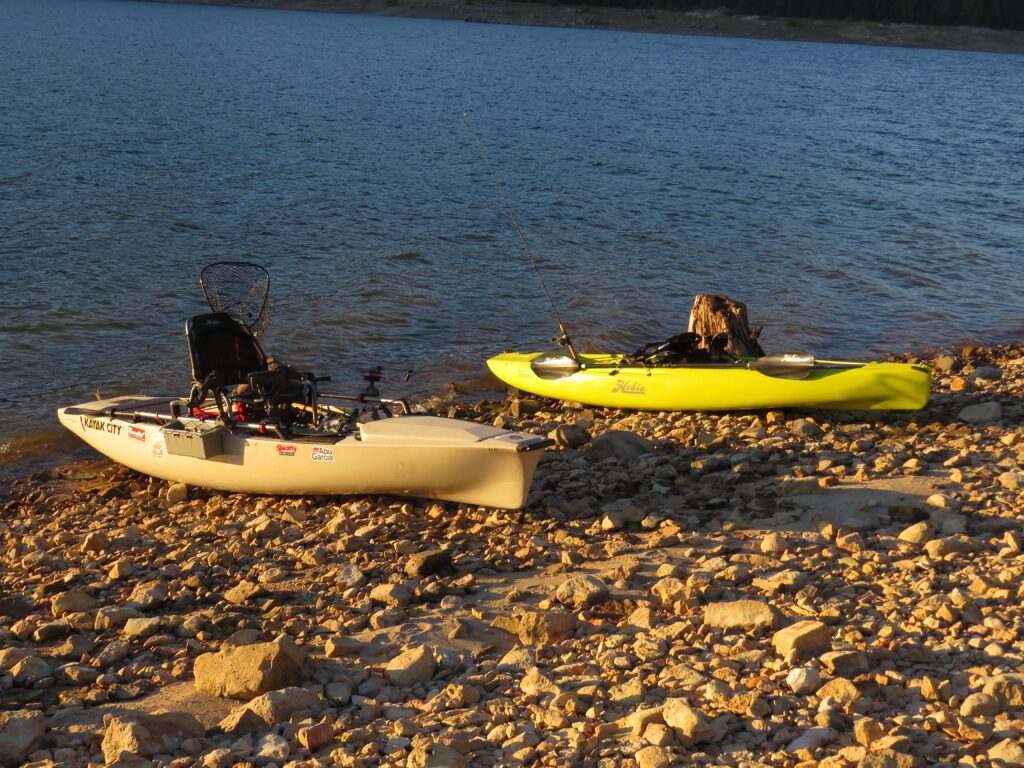Pedal Power! The Case For Kayak Fishing
The following appears in the March issue of California Sportsman:

By Cal Kellogg
Like many anglers in the Golden State, I started my fishing career from the bank at an early age. I caught plenty of trout, bass, catfish and such with my feet firmly anchored on the shoreline.
I didn’t get a boat until I was in my early 20s. I started out small with a 12-foot aluminum skiff. As time went by and I became a full-time outdoor writer, a whole new world opened for me. I went through a parade of sponsored boats. Each aluminum sled I ran was bigger and faster than the last.
Toward the end of my stint as a “sponsored” angler, I picked up my first kayak. I’d been interested in exploring the world of pedal kayak fishing for a long while. I quickly fell in love with kayaking.
These days, I operate my own guide service and spend a lot of time targeting trout and salmon from a big, comfortable pontoon boat, but I also have a fleet of kayaks and offer guided kayak fishing trips.
So, with these experiences under my belt, I can give you an honest assessment of kayak fishing and how it measures up against both bank and boat fishing.

EFFECTIVE FISHING CRAFTS
My first kayak was a 14-foot pedal-drive Hobie Pro Angler. On my first few trips getting acquainted with the kayak, I stuck to bass fishing, but as time went by, I outfitted the Pro Angler for trout trolling.
When I started trolling, I almost immediately started catching more and bigger trout using the same lures and approaches I’d always used. At first, I wondered if I was becoming a better angler, but since I hadn’t changed my presentations or basic strategy, it made no sense. I concluded my uptick in success was due to the kayak itself.
This belief was driven home to me when my partner Wes Ward and I started running both kayak and boat fishing guide trips at Collins Lake several years ago. Wes would often be guiding three green anglers who had never kayaked before on our fleet of pedal-drive Hobies, while I guided from our powerboat. Using the same presentations, Wes and his greenhorns often outfished the boat! Why?
For starters, kayaks are much stealthier than a boat. They displace far less water than a boat and cut through the water more quietly. They are also more maneuverable than a boat. When it comes to trout trolling, I always tell my clients that once they find the fish, they’ll want to cut the lake down and work the area that’s producing.
In a kayak it’s possible to make a 50-yard loop and stay in the strike zone all the time, be it an area off a point or in a cove. In the boat with trolling gear out, the loops I make are a few hundred yards long; as a result, I’m only in the strike zone part of the time.
As a kayak grinds on an area holding feeding trout, it doesn’t tend to spook the fish. In contrast, when I find shallow fish in the boat, I typically boat a handful, and then the big footprint of the boat puts the remaining fish off the bite.
A kayak also has the edge when it comes to working in tight to the shoreline. Game fish like trout will often move into shallow water only a few yards off the bank. If I want to troll for these fish from the pontoon boat, I’ve got to run a side planer up next to the shore, while a kayaker can troll the same zone with a pair of rods with no fear of hitting a submerged rock or spooking the fish.

CONVERTING THE DOUBTERS
Over the past few years, I’ve had the pleasure of introducing a growing list of anglers to kayaking who have gone out and bought their own kayaks.
The latest are Pete and Christine, a couple who live in Washington state and love trout fishing. Pete has a beautiful North River boat, but after I took the pair kayaking for cutthroats in the Sierra last summer, Pete picked up a pair of Hobies because of the effectiveness and simplicity of the platform compared to his big sled.
When it comes to trout and landlocked salmon trolling, I’m firmly convinced the kayak has the edge over a boat in terms of effectiveness.
How about bass fishing, or really any sort of fishing that requires casting, such as using spinning lures or flies for trout? Here again, the kayak option shines due to its stealth and nearshore maneuverability. I’m not a huge bass fisherman, but I do enjoy catching bass. I’ve found when targeting bass from the kayak, I can typically make much shorter casts, since I can move in tighter to the fish without scaring them.
It’s fun when you can flip out a worm or tube and hook bass 15 feet from the nose of your kayak in 2 feet of water. It’s even cooler when you find a pack of postspawn spots blitzing shad on the surface. You can inch right up to them in a kayak and enjoy outrageous, prolonged topwater action at close range.
In a boat you can only get two or three of those bass on a popper or walking bait before your presence chases the bass and the bait back into the depths.

Kayak angler Christine caught several handsome cutthroats at Prosser Reservoir last summer and fall, including this dandy fish. (CAL KELLOGG)
TALKIN’ SPECS
I’ll begin with a disclaimer: Everything I’m about to say is heavy on opinion and your mileage may vary!
You’ve seen the bargain-basement kayaks at the local big-box hardware or department stores. If you’re serious about fishing, what you get with one of these cheapo boats is $99 worth of frustration and a free dunk in the water if you attempt to stand up to cast or answer the call of nature. A dunk might be fun in summer; in the winter, it could be deadly.
If you’re serious about fishing, you need a serious fishing kayak. There are a lot of models available from a lot of different manufacturers. Some are paddle-propelled units and some feature pedals.
You can certainly catch plenty of fish from a paddle kayak, but for me, a serious fishing kayak must have a pedal propulsion system. Pedaling frees your hands for fishing, and your legs are stronger than your arms anyway. This means you can pedal longer and more efficiently than you can paddle.
If you want to troll, pedaling is 100 percent the way to go. I tell people not only do I catch trout trolling, but I also catch a nice zero-impact, calorie-burning workout!
You might be wondering about the new generation of kayaks that feature electric trolling motors. To each his own, but utilizing a motor just isn’t for me. I enjoy pedaling, and if I were using a motor, I’d constantly be worried about running out of juice and being stranded far from my vehicle.
There are also regulatory considerations when it comes to running a powered kayak in California. For starters, you’ll have to pay fees and get CF registration numbers on your kayak if you utilize a motor.
You’ll also become subject to snail and mussel inspections. I’ve heard a lot of stories from anglers in boats and motorized kayaks being turned away from lakes because an inspector discovered water in the craft.
I talk a lot about Hobie kayaks because I’ve always run Hobies. I want to make clear that I have no skin in the Hobie game. There are a lot of great pedal-drive kayaks available designed for serious fishing.
Pedal-drive fishing kayaks come in a lot of different sizes and weights, but most of them have one thing in common: They were all designed with bass fishing in mind, and why not? Black bass is the most popular game fish in the country.
Maybe you’re a bass angler or maybe a trouter like me. The point is this: think about bass fishing. Bass guys like to stand up and flip and rip and pitch and stuff like that. The key part of that phrase is “stand up.” Modern fishing kayaks are extremely stable and designed for you to stand on.
Everyone I take kayaking with has questions about stability. None of my clients or myself have ever come close to flipping or falling out of our kayaks.
The stability of a modern fishing kayak results from intense engineering. Fishing kayaks, compared to old-school whitewater kayaks, are extremely wide. For example, my Pro Angler is 46 inches wide in the cockpit area. Width lends stability for the angler who wants to stand up, but hull design is also a major factor.
Most fishing kayaks boast modified catamaran-style hulls. If you lean, the kayak will list to the side a bit, but the enlarged portion of the hull resists going below the surface, so there is a very positive “locking point.”
There are many videos on YouTube showing anglers not only standing in their kayaks, but actually walking around on them from bow to stern.

RANGE AND SAFETY
During a mild day of trolling, I cover 10 to 12 miles, and I’ve covered 20-plus miles many times. Obviously, pedal kayaks offer the ability to cover a lot of water. Due to the hull design of modern fishing kayaks, pedaling at a medium rate of speed in the 2- to 2.5-mph range requires little energy. Kayaks want to slide through the water, so pedaling them isn’t tiring. Very often when the conditions call for slow trolling, I must mentally force myself to slow down.
With an efficient pedal drive, you’ll be able to cover a small- to medium-sized lake in a single day. Larger lakes typically feature multiple launch ramps. Let’s say you’re up
on the Sac Arm of Lake Shasta but decide you want to check out the area near the dam. No problem; load up your kayak, jump on the freeway and drop back into the water at the other end of the lake.
The question begs: Are pedal-drive kayaks safe to use on large bodies of open water? Absolutely! I have been out on Eagle Lake when 30-plus-mph winds came up unexpectedly and was still able to safely navigate 3 miles back to the Gallatin Launch Ramp despite whitecaps rolling into my kayak’s self-bailing cockpit multiple times.
Of course, you wouldn’t plan a trip when the wind was gusting to 30, but I mention the incident to illustrate just how capable pedal-fishing kayaks can be in adverse conditions. Winds in the 10 to 15 mph range shouldn’t keep you from effectively fishing, and neither will chop and small whitecaps.
Most fishing kayaks with a pedal drive can take on ocean waters, so fishing your local reservoir on a breezy afternoon isn’t a problem.
When the weather is cold, I’ll often wear waders when fishing from my kayaks just to stay warm and dry, but during most of the year I wear water shoes and a pair of cargo shorts. The one thing that both my dog and constant kayak copilot Lucy and I wear on every outing without fail are lifejackets. As I said, I’ve never even come close to falling out of my Hobie, but every time we go out, I assume disaster will strike and we’ll end up in the water. Drowning isn’t part of our retirement plan, so wearing life jackets is nonnegotiable!
CONVENIENCE AND TRANSPORTING
As a guy who owns a big pontoon boat, I can attest that kayaks are easier to store, easier to launch and require less prep time than a boat. Once you’ve got your kayak dialed in to your needs, which is an ever-evolving process to some degree, your ’yak will feel like part of your own body. You’ll be one with the watercraft, and that’s a great feeling.
I told my buddy Pete up in Washington that now that he has a kayak, his big North River is going to get less and less use. So far, my prediction has been correct.
How you transport your kayak comes down to the size of the craft in question. My big Hobie Pro Angler 14, when loaded with a full range of camping and fishing gear, weighs in at over 200 pounds, hardly the sort of thing you are going to tuck under your arm and load on the top of your Prius. My Pro Angler rides on a modified utility trailer and I launch it just like I’d launch a boat.
On the other end of the spectrum, I have several 11-foot Hobie Lynx kayaks in my guiding fleet. The Lynx is a kayak with the soul of a paddleboard. It has no internal space or storage. It has an extremely stable 36-inch-wide deck, just like a paddle board, but it features a seat, rudder and Mirage Drive pedals. The hull weighs 45 pounds.
The Lynx can easily ride atop a small car or in the bed of a truck. It’s also a kayak you can attach wheels to and push or pull it to small, out-of-the-way lakes and ponds.
For my purposes, I’ve attached a lumber rack to my utility trailer. When guiding my Pro Angler, the “mother ship” rides on the deck of the trailer and the three Lynx kayaks are stacked and strapped on the lumber rack above.

FINAL ARGUMENTS
I never answered the question of whether kayak fishing is for you because only you can answer that question. Serious pedal-drive kayaks do represent a financial investment, so I would advise you to get out on the water on one before you make a purchase.
There are guys like me who offer introductory kayak trips and most kayak shops feature events that allow prospective kayakers to explore various models out on the water.
I will tell you that I’ve never taken out a person with an interest in trying a fishing kayak who didn’t like the experience, and as I mentioned, I’ve had several clients who have gone out and bought their own kayaks.
I’ll leave you with this warning: If you’re an avid angler and you try kayaking, there is a very good chance your wallet will get a little thinner, because you’re going to want a kayak of your own! CS



